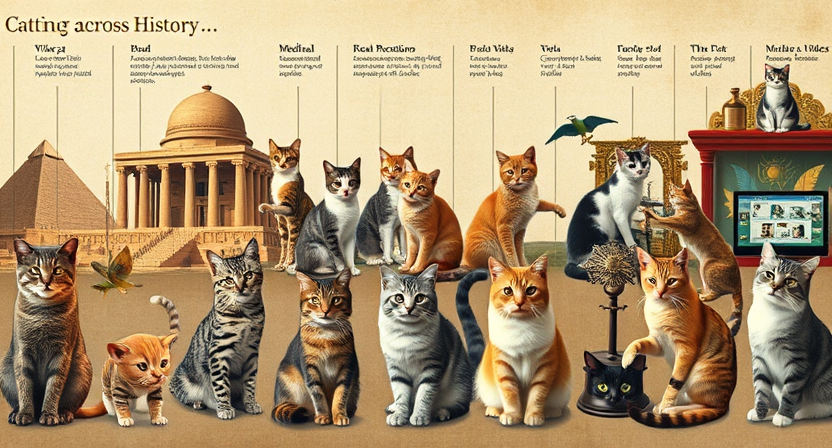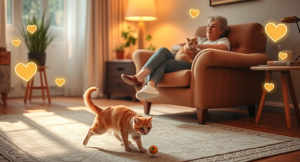
The Fascinating History of Cats
Ancient Origins: Tracing the Earliest Domestication of Cats

The domestication of cats is a topic that has intrigued researchers and historians alike for centuries. While the exact timeline and locations of the earliest cat domestication remain unclear, archaeological evidence suggests that this process occurred in multiple regions around the world. From the Near East to ancient Egypt, cats were valued for their hunting abilities and gradually became companions to humans. The relationship between humans and cats during this early period is fascinating to explore, shedding light on the ancient origins of our bond with these enigmatic creatures.
In the Near East, evidence of cat domestication dates back as far as 9,000 years ago, with remains found in present-day Cyprus. The incorporation of cats into human settlements can be seen through the discovery of cat bones in early agricultural communities. It is believed that cats were attracted to these settlements due to the presence of rodents, seeking food sources and shelter. As humans recognized the benefits of having cats around to control pest populations, a mutual relationship developed, leading to the gradual domestication of these independent creatures.
Feline Deities: Cats in Ancient Egyptian Culture and Religion

Ancient Egyptian culture and religion were deeply intertwined with the presence of cats. In this civilization, cats held a divine status and were considered sacred beings. They were associated with the goddess Bastet, who was depicted with the head of a lioness or a domestic cat. Bastet was the goddess of home, fertility, and protection, and she was regarded as a kind and benevolent deity.
Cats were not only symbolic representations of the goddess, but they were also considered to possess her divine qualities. They were revered as guardians of the home and were believed to ward off evil spirits and bring good fortune to their human companions. Egyptians believed that owning a cat would bring prosperity and abundance to their households, and as a result, cats were highly cherished and cared for. They were even mummified and buried alongside their owners to ensure a prosperous afterlife. The significance of cats in ancient Egyptian culture highlights the deep veneration and spiritual connection they held in this civilization.
Guardians of the Grain: Cats in Ancient Agriculture and Trade

Cats played a vital role in ancient agriculture and trade, particularly in regions where grains were grown and stored. As natural predators, cats helped control the population of rodents, such as mice and rats, that posed a threat to stored crops. Their ability to hunt and catch these pests made them invaluable allies in protecting the grain reserves that sustained ancient civilizations. Farmers and merchants soon began to see the value of having cats around their fields, granaries, and marketplaces, leading to the intentional domestication and breeding of cats for agricultural purposes.
The presence of cats in ancient trade can be traced back to their role in safeguarding precious goods on merchant ships and in bustling ports. While cats were primarily kept aboard ships to control rats and mice that could damage cargo, they also offered companionship and a sense of comfort to sailors during long and arduous journeys. In ports, cats were known to be highly effective in keeping warehouses and storerooms free from vermin, ensuring that imported grains and other commodities remained untainted and unspoiled. Their contribution to the maintenance of trade networks and the preservation of valuable food supplies cannot be overstated, solidifying their status as guardians of the grain in the world of ancient agriculture and commerce.
Medieval Superstitions: The Persecution and Reverence of Cats

During the medieval period, cats were subjected to both persecution and reverence, their status in society often dictated by prevailing superstitions. On one hand, cats were associated with witchcraft and were seen as companions to witches, even being believed to possess magical powers themselves. This perception fueled a widespread fear and hatred towards cats, leading to their systematic persecution and mass killings.
On the other hand, there were pockets of society that revered cats, recognizing their invaluable role in controlling vermin populations. These individuals understood that cats were instrumental in preventing the spread of disease and protecting precious food supplies. In monasteries and farms, cats were cherished for their abilities as pest controllers, and efforts were made to provide them with shelter and nourishment. Cats were seen as guardians, keeping their human companions safe from the dangers posed by rats and mice. Despite the superstitions surrounding them, cats had a place in medieval society, both as symbols of evil and as essential allies in the fight against vermin.
Mysterious Witchcraft: Cats in Folklore and Mythology

Cats have long been associated with mystery and magic in folklore and mythology. In ancient times, they were believed to possess supernatural powers and were often revered as familiars – spirits that aided witches and sorcerers in their mystical endeavors. In some cultures, cats were even considered to be shape-shifters, able to transform into humans or other animals at will. These beliefs gave rise to numerous myths and legends surrounding cats, cementing their reputation as enigmatic creatures with ties to the supernatural.
One such myth is the widespread belief that cats possess the ability to see spirits and communicate with the otherworldly realm. It was said that they could act as intermediaries between humans and the spirit world, providing insight and protection against evil forces. This belief led to cats being highly valued and cherished by those practicing witchcraft, as their purported connection to the supernatural made them indispensable companions and protectors. Despite their association with dark arts, cats were also revered and feared by some, seen as symbols of good luck and fortune. These conflicting beliefs only added to the intrigue surrounding cats in folklore and mythology, perpetuating the air of mystery that surrounds them to this day.
Shipmates and Pest Controllers: Cats on Sailboats and in Ports

Cats have a long history of being companions to sailors and playing a vital role in maritime life. Sailboats and ports were often infested with rats and other vermin, which posed a threat to the cargo and the sailors themselves. Cats were brought on board ships to control these pests, as their natural hunting instincts and agility made them excellent pest controllers.
The presence of cats on sailboats not only helped keep the ship’s stores free from rodents but also provided companionship to the sailors during long journeys at sea. Many sailors formed strong bonds with their feline shipmates, finding comfort in their presence and relying on their companionship for solace. Cats became an integral part of maritime culture, symbolizing good luck and protection from ill omens. Their presence on board inspired superstitions and traditions, such as believing that a cat washing its face meant the weather would soon clear up.
Renaissance Pets: Cats in European Art and Literature

Cats held a prominent place in both European art and literature during the Renaissance. Artists such as Leonardo da Vinci and Albrecht Dürer frequently included cats in their paintings and drawings, considering them elegant and enigmatic subjects. These feline figures often symbolized different concepts, such as the duality of human nature or the mysterious nature of women. Furthermore, cats were not only portrayed as pets but also as powerful entities with supernatural abilities in literary works. Their presence in works by authors like Giovanni Boccaccio and Christine de Pizan added a touch of intrigue and mystique to the narratives. The Renaissance period truly celebrated the beauty and allure of cats, showcasing their grace and mystery through various artistic and literary mediums.
The Cat Craze: Cats in Victorian Society and Popular Culture

In Victorian society, cats gained immense popularity and became an integral part of the domestic life. These furry creatures were seen as fashionable companions and were often depicted in artwork, literature, and even fashion trends of the time. Cats were particularly favored by women, who considered them as symbols of grace, elegance, and independence. They were often shown in paintings and decorative items, adorning the homes of the wealthy.
In addition to being fashionable pets, cats also served a practical purpose in Victorian society. They were valued for their ability to keep homes and businesses free from mice and rats. Their hunting skills were highly esteemed, and many people relied on cats to protect their properties and belongings from these common pests. As a result, cats became an essential part of trade establishments, ships, and even in public areas, such as markets and ports. Their presence was believed to bring good luck and ward off evil spirits, further solidifying their importance in popular culture.
Feline Heroes: Cats in World War I and II

During times of war, cats played a vital role in providing comfort and companionship to soldiers. In World War I and II, feline heroes became an important part of military units, serving as mascots and even participating in missions. These courageous cats not only provided a sense of morale and normalcy amidst the chaos of war, but they also helped to control the rodent population in trenches and on ships.
One remarkable example is “Simon,” a black and white ship’s cat who served aboard the HMS Amethyst during the Yangtze Incident in 1949. Despite being wounded by shrapnel during an attack, Simon continued to do his duties, catching rats and boosting the crew’s morale. His dedication earned him the prestigious PDSA Dickin Medal, making him the only cat to have received such an honor. Simon’s bravery, along with the many other feline heroes of war, is a testament to the extraordinary bond between cats and humans in times of adversity.
Modern Cat Obsession: Cats in the Digital Age

In this era of the digital age, it is no surprise that cats have taken over the internet. They have become the unofficial mascots of the online world, with countless memes, videos, and social media accounts dedicated solely to their antics. From cute and cuddly kittens to hilarious and mischievous feline behaviors, it seems that everyone has fallen under the spell of these internet sensations.
One of the main reasons for the modern cat obsession in the digital age is the innate charm and entertainment value that cats possess. Their playful antics and mysterious persona make them perfect subjects for viral content. People are instantly drawn to their adorable faces and amusing behaviors, and are eager to share these moments with others through various online platforms. Additionally, the ease of capturing and sharing cat-related content on smartphones and social media has contributed to the exponential growth of cat-focused communities online. These communities provide a sense of camaraderie among cat lovers, as they can connect, relate, and engage with fellow enthusiasts from all corners of the globe. From dedicated Facebook groups to Instagram accounts with millions of followers, the digital age has allowed cat lovers to unite and appreciate their shared obsession for these wonderful creatures.


